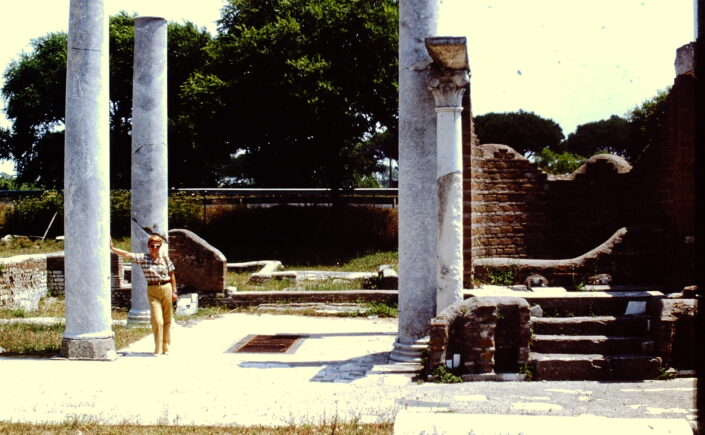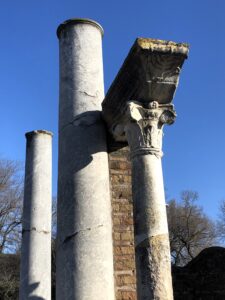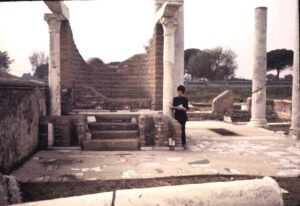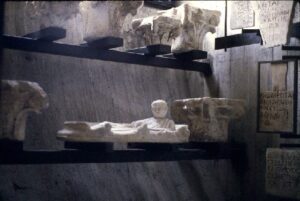Excerpt from: Estelle Shohet Brettman, Vaults of Memory: The Roman Jewish Catacombs and their Context in the Ancient Mediterranean World, rev. ed. Amy K. Hirschfeld, Florence Wolsky, & Jessica Dello Russo. Boston: International Catacomb Society, 1991-2017 (rev. 2024).
In spite of considerable epigraphic evidence brought to light over many centuries concerning ancient Jewish communities in Italy, the first material evidence of an ancient Italian synagogue structure was uncovered fairly recently at Ostia Antica, the Trajanic-era port of ancient Rome. Around 1961, during construction work on a highway to the new airport at Fiumicino, the remains of a fourth century synagogue were found, built over earlier structural remains which used the opus reticulatum masonry technique common to the first and second centuries CE.
As documented in the initial excavation and in successive site studies, modifications were made to the complex over time. A late second/early third century marble epigraph in Latin and Greek, dedicated by one Mindis Faustos "for the emperor's well-being", commemorated the donation of an ark for the Sacred Law. Dr. Maria Floriani Squarciapino, the archaeological superintendent of Ostia in charge of the original synagogue excavation, believed that this commemorative stone (which, finally, face-down, was used to repair the floor in the inner hall of the later synagogue) and the plan of the original building are proof that the structure at that site was always a synagogue, and that a continuous and prosperous Jewish colony must have lived at Ostia from the first century CE to, at least, the fourth.[i]
The ruins of the Late Ancient synagogue complex include a four-stepped podium supporting a small tabernacle (aedicula) in the form of an apsidal niche with columns, situated inside the main hall and near the entrance, that was meant to hold the Torah ark. Resting on the columns were two sections of architrave which extended from the back wall and probably supported a pediment bridging the front opening of the aedicula. Featured in the decorations of the synagogue and carved in relief on the anterior short ends of the architrave in low relief, with traces of gilding, are the ritual objects - lulav, ethrog, and shofar- flanking the representation of a bejeweled menorah.[ii]
Since the discovery of this synagogue at Ostia Antica in the early 1960's, other evidence of Jewish cultic buildings has emerged in southern Italy. In 1985, during a highway project in Calabria, excavators at Bova Marina discovered the mosaic floor of a fourth century synagogue showing a menorah; under this floor may also be the remains of an older synagogue.[iii] This was followed, in 1988, by Dr. Marisa de' Spagnolis's find at Nocera of the two inscriptions of a husband and wife, grammateus and presbytera, that could have been displayed a synagogue building at Nuceria Alfaterna (Nocera Superiore), although they were revealed in a funerary context, apparently in secondary use.[iv]
The recent finds in the territory of Ostia, in addition to several earlier finds noted by Frey, could lend credence to his thesis that certain Jewish inscriptions coming from Porto might have originated in a cemetery in that location.[v] The earlier finds include a decree from nearby Castel Porziano recording the transfer of land for a family tomb as a gift from a Jewish community to one of its honored members, a Jewish epitaph, and a marble capital with four menorot lightly incised between the volutes.[vi] In light of the evolving record of Ostia's Jews, the members of the synagogues mentioned in the Porto inscriptions could have worshipped in synagogues in Rome, or that, perhaps, the Roman congregations had affiliations with synagogues in the thriving port, to which there was a direct connection from the capital by way of the Via Portuense). This capital, found with six other capitals, might have originally been architectural embellishments for a Jewish structure that Frey presumed to have been a synagogue.[vii] They were discovered among the ruins of the edifice at Porto that was considered to be a xenodocheion (a type of Christian hospice for pilgrims traveling to Rome) with an attached basilica. The "earliest of its kind," it was built by Pammachius in 398 and mentioned in the letters of St. Jerome.[viii]
Frey records other finds at Ostia indicating a Jewish presence there, specifically an amulet which bore Solomon's name on one side and a five-branched lamp-stand on the other, and a a terra cotta lamp impressed with a menorah.[ix] Discovered more recently, in 1969, in the southern region of ancient Ostia, the inscription of one Plotius Fortunatus, noteworthy for providing evidence of the title of archisynagogos in Ostia.[x]
The cosmopolitan nature of this bustling international port and its environs is strikingly evidenced by the offices of the Piazzale delle Corporazioni at Ostia Antica. During the reign of the Emperor Augustus (27 BCE - 14 CE), an intense period of building was begun in Ostia, including the erection of a theatre with a large square behind it. Around this square are the ruins of around seventy offices that were once occupied by merchants from far-flung regions of the Roman Empire. Porticos in front of the offices shaded black and white mosaic pavements, many of which were decorated with emblems denoting the place of origin of the enterprises and sometimes suggesting the nature of the trade conducted on the premises. In one example, the inlaid figuration of an elephant represented a firm from Sabratha in modern Libya. As the "bread basket" of imperial Rome, North Africa supplied grain for the annona distribution to the populace, as well as luxury goods, including ostrich feathers, ivory, gold dust, and animals for the Roman spectacles.
The traces of one or more thriving Jewish communities in or near Ostia Antica suggests that a number of Jews and early Christians in Rome were engaged in commerce, perhaps also accounting for some of the more elegant and costly tombstones, sarcophagi, and decorated funerary chambers encountered by excavators, although less frequently in the Jewish cemeteries of Rome than in those of Christians and other societies.
[i] M. Floriani Squarciapino, "The Synagogue at Ostia," in Archaeology 16.3 (1963), pp. 194-203. Differences in the style of script on this inscription make it uncertain, however, whether Mindis Faustos was the original donor.
[ii] Squarciapino, Archaeology, 16.3, p. 194, plan.
[iii] E. Lattanzi, "L'attivita' archeologica in Calabria nel 1985 in Neapolis," in Atti del 25 Convegno di Studi sulla Magna Grecia, Taranto 3-7 ottobre 1985 (Taranto: L'arte tipografica, 1986), pp. 420-421.
[iv] M. de' Spagnolis Conticello, “New Light on Women's Roles in the Ancient Synagogues of the Roman Empire”, in ICS Varia (2018): https://www.catacombsociety.org/ics-varia/.
[v] G B. de Rossi, Bullettino di Archeologia Cristiana, 4.3, p. 40. Inscription CIJ 1.533; JIWE 1.18, pp. 32-35, from Porto, is dated by Frey in the CIJ to the "first half of the second century".
[vi] J-B. Frey, “Inscriptions juives inédites (1)," in Rivista di Archeologia Cristiana 8, nos. 1-2, pp. 83-90 and notes, but Leon disputed Frey's theories on the Jewish epitaphs and capitals in H. J. Leon, "The Jewish Community of Ancient Porto", in Harvard Theological Review 45.3 (1952), pp. 165-175).
[vii] Frey, "Inscriptions juives inédites," p. 84.
[viii] De Rossi, Bullettino di Archeologia Cristiana 4.3 (1884), pp. 50, 99-103.
[ix] In succeeding decades, other specimens would be found: Frey, "Inscriptions juives inédites," p. 89, n. 1, describing this as the first artifact with Jewish markers documented in situ in Ostia.
[x] JIWE 1.14, pp. 25-28, pl. 7; M. Floriani Squarciapino, "Plotius Fortunatus archisynagogos," in La Rassegna Mensile di Israele 36 (1970), pp. 183-191.



